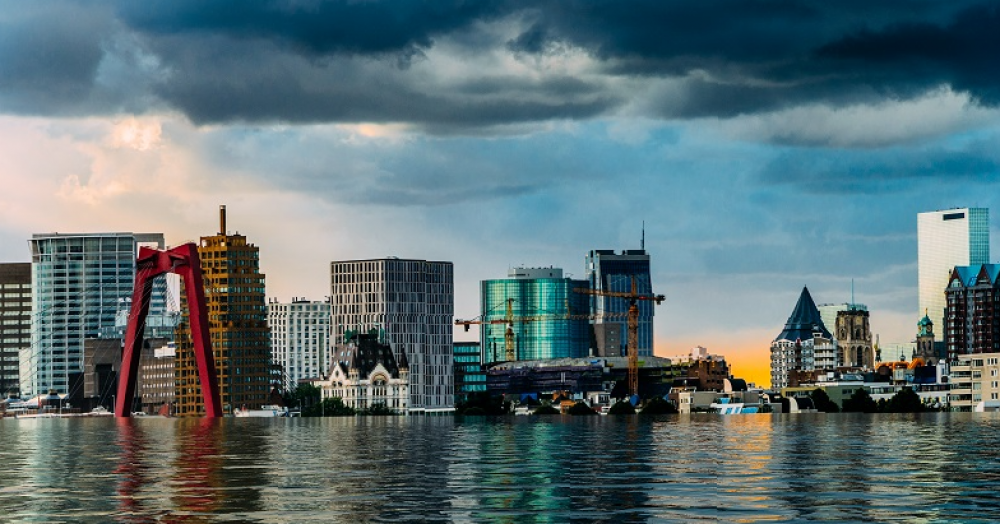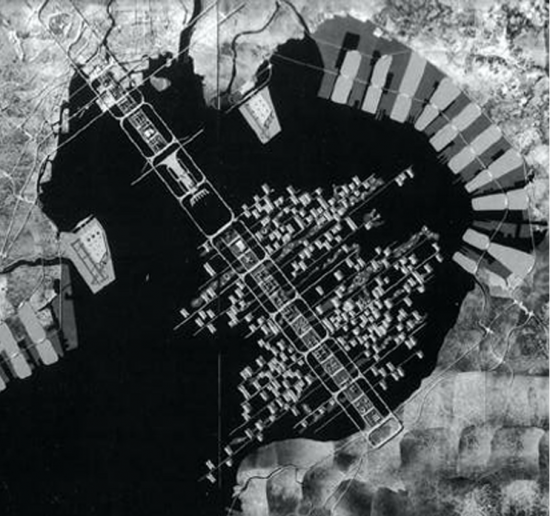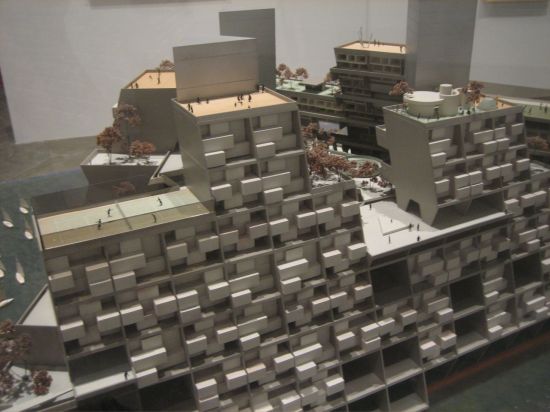Coastal cities have for decades been finding ways to cope with floods, storm surges, subsidence and other disasters, which are worsening with climate change. As Stefan Huebner of the Asia Research Institute at National University of Singapore writes, instead of focusing only on how to control the movement of water, cities should also embrace the ongoing “amphibious transformation” by adapting to life on water.
Dystopian urban future: With the rising sea level and extreme weather induced by climate change, cities should aim not just to control the movement of water but also to adapt to life on it (Credit: Alexandre Rotenberg / Shutterstock.com)
Earth’s surface is experiencing what I call an “amphibious transformation”. The sea-level rise due to climate change, which threatens many coastal cities around the world including in Asia, is shaping global discussions about urbanization and has brought back questions about adaptation to unstable marine surfaces. In this context, ideas and practices of floating and elevated structures are gaining global significance.
Even far away from the sea, flood disasters regularly happen, as was illustrated by the recent flooding in Europe, some of which hit areas not far from my home town in Germany, were the result of rainfalls and rivers. An overview of historical sources on flooding in the Ahr Valley going back to the late Middle Ages illustrates that this region regularly experienced floods. The reasons why hundreds of people have died or gone missing and why whole houses were washed away are manifold but one wonders why both individual and collective preparations for severe flooding were apparently limited.
Climate change is expected to make both coastal and river floods more severe, adding to the challenge. Organizations such as the Intergovernmental Panel on Climate Change (IPCC) have emphasized that climate-change mitigation alone is no longer sufficient: There is an urgent need for both mitigation and adaptation.
In 2019, the United Nations in New York hosted a roundtable on sustainable floating cities, discussing floating platform-based extensions of coastal cities and independent, growable offshore settlements. This year, the Rotterdam-based Global Center on Adaptation received a floating office building, which will not be affected by water level changes. Such floating or elevated structures are essentially counterproposals or alternatives to hydroelectric dams, seawalls and similar urban and regional development projects that focus on removing and controlling water rather than adapting to water flows and changes in water level.
During the 20th and 21st centuries, the rapidly growing number of offshore structures, which often constitute unconventional settlements, contributed greatly to the amphibious transformation of the earth’s surface. For humans, it meant that both terrestrial and aquatic areas have turned into habitats. I call this transformation “amphibious” as it does not result in a change of the physical properties of marine regions, as would have happened in the case of terrestrialization through land reclamation and water removal. I call it a “transformation” because, around the world, the large-scale offshore expansion of communication systems based on radio- or internet-connected devices, including transportation and energy networks that are operated and controlled by them, is a central reason for regarding the development of marine surfaces as a specific element of amphibious urbanization and industrialization.
How and why are the rising numbers of floating and elevated structures, high-speed communication networks bridging land and sea, and new applications of artificial intelligence (AI) such as machine learning and computer vision contributing to amphibious transformation, urbanization’s spread into the sea and adaptation to rising sea levels?
As I recently illustrated in an article published in Modern Asian Studies, many of the design ideas that shape amphibious transformation emerged during the 1960s from provocative but unrealized proposals to urbanize Tokyo Bay. The ideas and practices were overshadowed by what I call a “global terrestrial mindset” in urban and regional development but have nonetheless continued to evolve. Due to the more obvious limitations and ecological footprints of terrestrialization projects, they are regaining political legitimacy.
I will first explain the impact of this global terrestrial mindset and its limitations before investigating the interplay among floating and elevated structures, global communication networks, and machine learning as major factors in amphibious transformation.
The global terrestrial mindset
Before a global terrestrial mindset dominated thinking in urban and regional development in the 20th century, humans adapting to amphibious or aquatic habitats was not uncommon. Growing historical and anthropological literature on Asian river deltas shows how perennial floods in fertile floodplains shaped the awareness of people and their settlement practices. Other studies addressed, for example, “boat people” in East and Southeast Asia who for centuries adapted to life on boats, which included the creation of unconventional forms of urbanization on the waterfronts of Tokyo, Hong Kong and many other cities.
Over the 20th century, the world went through a spree of hydroelectric dam construction, land reclamation, and coastal defense upgrading, thereby causing or intensifying this global terrestrial mindset that turned water into an object of fear and danger. To be sure, hydroelectric dam construction created water reservoirs (and forced the relocation of local people), but my point is that a by far greater area experienced land reclamation through the control and removal of water that had perennially flooded amphibious environments. This terrestrialization process changed floodplains into places where terrestrial settlement and industrialization strategies could be applied. Today, the vast majority of dams are located in Asia, particularly in China. Such projects are strong contributions to and expressions of the terrestrial mindset in urban and regional development.
Some of the first counterproposals or alternatives to such terrestrialization projects emerged in planning for Tokyo Bay. By 1960, the Japanese capital’s population growth and urban congestion meant that urbanizing the waterfront through land reclamation or alternatives became a topic of debate. Star Japanese architect Tange Kenzō’s “Plan for Tokyo 1960” (released in 1961) and well-known US designer R Buckminster Fuller’s floating design called the “Tetrahedronal City” (developed between 1966 and 1968) emphasized the important role that communication network expansion has played in shaping marine urbanization. The ideas behind their designs, though technologically outdated, remain alive and relevant.
Applying communication technology to enable floating or elevated structures to interact with the physical properties of marine surfaces artificially recreated the biological processes of growth (by adding additional modular elements to the structure), adaptation (by making the structure resilient to wind and waves, etc.), mobility (by enabling the structure to change location), and autonomy (meaning the structure’s self-sufficiency). These ideas became central environmental-political strands for marine urbanization and reducing its ecological footprint – even though the cybernetics bio-informational language of brains and neural networks disappeared.
Some characteristics of Fuller’s design, which drew on Tange’s and his team’s ideas, illustrate why I argue that it should be seen as one of amphibious transformation’s alternatives to large hydroelectric dams. Dams are urban and regional development tools for storing freshwater, regulating its availability all year around, and generating electricity for industrialization and urban consumption.
To provide such electricity and freshwater, Fuller proposed an aircraft carrier-style combination of nuclear reactor and desalination plant to make his floating structure autonomous. The average hydroelectric dam also has a substantial ecological footprint through terrestrializing a huge space and reducing sediment flux from upstream that then often cannot compensate for erosion, meaning that many river deltas are sinking more rapidly than sea levels are rising. Mobility and adaptation to marine surfaces increased the sustainability of Fuller’s design in the sense that the structure’s full lifespan could be utilized.
Over the following decades, this concept of modularization of floating units was further refined. Current designs have utilized only mobile floating units that together would form a growable structure. Examples include one by the Bjarke Ingels Group, which was a result of the 2019 UN roundtable. The designer considered the Pearl River Delta as a possible test site. At the roundtable, UN Deputy Secretary-General Amina Mohammed, who was Nigeria’s minister of environment from 2015-16, spoke of the planned autonomy of such structures. She suggested that the adaptive floating structure could rely on its own solar power to mitigate climate change and fuel an electric vehicle-based transportation infrastructure.
The ocean and global communications networks
The growing number of high-tech floating and elevated offshore structures, the large-scale expansion of communication networks to marine surfaces, and new applications of AI such as machine learning and computer vision are important factors in amphibious transformation. Such communication networks create what in this article is understood as urbanization, meaning not the concentration of a number of people in a certain area but access to networks that realize global urban connectivity.
Marine urbanization is a topic that will shape the 21st century. After all, the number of unconventional offshore settlements and industrial facilities, as well as their footprints, are rapidly growing. Since the 1940s, thousands of floating or fixed oil and gas platforms have enabled humans to work permanently offshore while remaining connected to global communication networks. Other floating or fixed structures include harbor facilities, liquefied natural gas (LNG) terminals, helipads, oil storage, bridges, huge mariculture (marine organism farming) operations, military installations, nuclear power plants, breakwaters, dairy farms, gardens, hotels, and mass-produced high-tech floating homes. One can also add vessels that provide residential and industrial facilities for people such as cruise ships, aircraft carriers, and factory ships for freezing and processing fish.
In near-shore regions, cables and radio towers may connect structures to high-speed communication networks. Further offshore, communication satellites, which were first launched in the 1960s, provide low data rate-based network access including telephone, TV, radio, and (very slow) internet. For decades, navigation systems on ships and platforms have also relied on the Global Positioning System (GPS) and its predecessors. Some of the very recent transformations on and partially below marine surfaces illustrate the tremendous expansion of communication networks.
Smart offshore structures
With demand for server space rapidly increasing, driven by cloud applications and gaming, blockchain technology, streaming and other uses, underwater server farms could become a major ocean industrialization project, adapting to marine conditions to become more autonomous in terms of electricity supply. Microsoft in 2020 stated that a two-year test of an underwater server farm off Scotland was successful, enabling seawater-based cooling that strongly reduced power demand, which was covered by renewable energy. Chinese companies this year began to test underwater server farms off the Hainan free trade port. If constructed at scale and in combination with other offshore structures, underwater server farms will likely become a matter of debate.
While internet-based communication systems rely on server space, they depend on connectivity even more. Space exploration company SpaceX’s ongoing Starlink satellite internet project provides the company’s growing number of offshore rocket launch and landing platforms with high-speed internet access. According to CEO Elon Musk, Starlink promises eventually to enable high-speed internet access even further offshore on ships.
Hearkening back to Tange’s and Fuller’s early cybernetic ideas in marine urbanization, present smart offshore structures connected to the internet constitute artificial communication systems. They still replicate the biological communications of human organs such as eyes and muscles, which are connected through the neural network, allowing humans to recognize and adapt to changing environmental conditions.
Integrating new smart offshore structures into the “internet of things” makes them more autonomous by enabling them to collect real-time data on damage and to make calls for repairs, or to receive meteorological information and respond automatically by shutting down offshore wind turbines during an approaching storm or adjusting floating solar panels according to movement of the sun. In the long run, ride-hailing services may extend to ocean surfaces and support remote work, one of the digitization trends that the pandemic accelerated, which allows people to earn a living from any place where there is online access.
Satellites also extend communication networks in other ways beyond granting offshore access to the internet. Earth observation satellites, for example, help to study Chinese island reclamation projects and the military build-up in the South China Sea. Since the 1960s, satellite images have been providing weather data and capturing marine conditions, ranging from fog, icebergs or the extent of oil spills to surface temperature and, based on the color of the water, the amount of phytoplankton in the sea. Machine learning and computer vision AI tools are now being applied to analyze satellite images to spot illegal activities such as piracy and trafficking, to support autonomous ships, and to recognize approaching natural disasters. Combining the historical data provided by satellite images with real-time “internet of things” data will be relevant for both the design of offshore structures as well as to take out insurance for them, usually a precondition for construction.
Given the amphibious transformation driven by marine urbanization and industrialization, climate change adaptation and mitigation approaches of coastal cities should not be evaluated exclusively with a terrestrial mindset. Vulnerability to floods and storm surges, subsidence, and other disasters is a fast-growing challenge. The anthropogenic rise of sea levels will only intensify their impact, and they are problems that cannot be fully dealt with a terrestrial mindset and its exclusive focus on controlling and removing water. Amphibious or floating adaptation approaches are easily ignored, denied outright, marginalized, or branded as utopian, even though the earth’s surface has continued to experience amphibious transformation through communication network expansion as well as advances in amphibious and floating architecture.
Further reading:
Check out here for more research and analysis from Asian perspectives.


